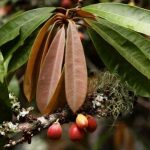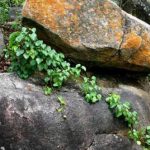TREE LIFE
FEBRUARY 1992
MASHONALAND CALENDAR
Tuesday 4th February : Botanic Garden walk at 4.145 for 5 pm. Park at the Herbariun where we will meet Tom Muller.
Sunday 16th February : To Lionel Henriquee property New Erewhon in the Arcturus area. Many numbers will remember an enjoyable day at New Erewhon in November 1984, and will agree that given the chance we should return. Well happily that chance has come and we will meet at the homestead at 10.00 am.
Saturday 22nd February : Mark will be away so there will be no walk.
Tuesday 3rdMarch : Botanic Garden Walk.
MATABELELAND CALANDAR
Sunday 2nd February 1992 : To Lumane Falls in the eastern Matopos. A change of meeting place – now to meet at Clem van Vliet’s house, 4 Carnarvon Road, Hillside (Just off Cecil Avenue, opposite the Teachers Training College) at 8.30 am — where cars can be left in safety. From there we will proceed along the new road to the Gwanda Road, out to the right hand turn-off to Diana’s Pool. This road for 20 km is not usually of the best, but the scenery makes up for it. From Esibomvu the road improves until the last 3 km to the car parking area of’ the Lumane Falls (distance about 70 km). We also hope to find the relic tree fern forest, and if time permits to go to Diana’s Pool and the orbicular granite national monument site. All day – bring teatime, lunch and chairs – and stand by for a real treat! If it pours down in torrents before then (three cheers) we will find an alternative!
Wednesday 12th February : McHEW – at Hillside dam at 5 pm — this might soon become McPew at Mabukuwene — but we will let you know.
Sunday 1st March, 1992 : A new venue – easy to get to – Khami waterworks. We will Meet at Grafotype, 51 Plumtree Road, Donnington (at 8.30 am) where cars be left under lock and key – and proceed along the new Siyi Pambili Road (new for most people) to turn left into Khami Road and on to the turn-off to Khami Gaol at 15 km – from here it is 5 km on tar to the waterworks and trees/rock/water. Morning only bring teatime and chairs – very attractive.
Wednesday 18th March : We will try the new McHew – meet at Mabukuwene on Chipping way, Burnside at 5 pm.
On Sunday, December 1st, we went to the Mguza Nature Reserve, and had a good turnout perhaps because there has been a good deal of development there, and we had not visited for some time. Also, of course, these days of costly petrol, local trips are welcome.
We found over 80 species, in our wanderings, which included rather more than we expected. We added quite a few species to the card for the area, which, I think stands at 108.
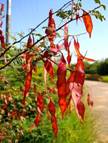
Acacia chariessa. Photo: L.A.Lauritsen Source: Flora of Zimbabwe
Among the trees of interest were Acacia chariessa, A.galpinii, A.mellifera, A.tortilis, Boscia salicifolia, Cadaba termitaria, Carissa bisginosa, Clerodendrum myricoides, flowering, Combretum erythrophyllum, Commiphora schimperi, Diospyros lycioides, fruiting, Ehratia rigida, flowering profusely, Elephantorrhiza goetzii, with extra large pods, Euclea undulata, Faurea saligna, one lone large tree, Gardenia ternifolia,Maytenus heterphylla, subsp. puberula, Mundulea sericea, flowering well, Ochna puberula, flowering and fruiting, Pavetta gardenifolia, right in among the rocks Psiadia punctulata, flowering, Pterocarpus rotundifolius, Rhiqozum brevispinosum which had flowered well, but were just getting over, Rhus laptodictya, Sclercarya birrea, Terminalia randii, Tetredenia brevispicata, many Ximenia arnericana, and a few Ximenia caffra, Zanthoxylum chalybaum, with large red-brown hooked thorns, rather Acacia-like. This last we do not often encounter.
C. SYKES
EWANRIGG : A Christmas Story
Once upon a time (well over fifty years ago) a sad little Aloe lay on the bare rocky hillside where he had been tossed by a stranger who had taken him away from his family and brought him there. But Mother Nature would have none of it and told the little Aloe to get up and put his feet down and lift his arms to the sun and so he did. And one day when he grew beautiful red leaves and red and yellow flowers a Christian Prince passed by and was so delighted with this brave and pretty Aloe that he decided there and then to create an enchanted garden with lots of Aloes for everyone to enjoy and where the birds would sing all day. Yes, a fairy tale, but this time a true one, but Christmas is a time for fables and stories of such events and so on this Sunday before Christmas the Tree Society gathered to walk in the enchanted garden and listen to the bird song.
For too long has Ewanrigg been referred to as an “Aloe garden” and for too long has it been said that only during a few months of the year is it worth visiting, when the Aloes are at the height of their glory and sunbirds abound. Not so — when the flamboyants have faded the quiet side of Ewanrigg can come into its own. We gathered under the coolness of the spreading American Ash trees on the lawns where initially, Kim sent us off to find the names of trees in alphabetical order – not too difficult because most of the trees are labelled. The game was not serious and prize giving brought forth a most interesting botanical discussion in Kim’s inimitable style. There was time before lunch for a- walk and this led us up to the ponds ablaze with water lilies of all colours and many little creatures enjoying the summer sun.
Here was the Monster of our fairy tale; amongst pale lemon water lilies we espied “Moby Dick”, the pride of the gardens shading under a large leaf. You will have Guessed – he is a Koi. Here too we found the dragons! Brilliant red and blue dragon flies, precariously sitting on the reeds at the pond edge hoping to pounce upon an unwary female and then nearly drowning her by pushing her down to the bottom of the pond to lay the eggs he has just fertilised.
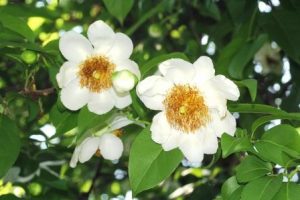
Oncoba spinosa. Photo: Bart Wursten. Source: Flora of Zimbabwe
On the lawns and around the verges are trees from other lands interspersed with our own indigenous trees; many Acacia and Combretum with an amazing variety of pod colours. The Ficus retusa from South Africa had bunches of pale berries, the Oncoba spinosa reminded us of the Zambezi Valley where the ‘shake shake’ pods are used to tie to arms and ankles to add rhythm during a dance. Perhaps to uphold the reputation of the garden there was one Aloe in bloom, a pink flowering Aloe pluridens from South Africa. At this time most of the Aloes look dejected because of their untidy beards. Before we reached the herb garden we found the proverbial serpent in the garden, a light green Cissus quadrangularis snaking up a tree and close by clusters of pale yellow Loranthus. There are many species of this parasite and they are not too fussy about their hosts but prefer Acacias, Albizia, Brachystegia, Ficus etc. This yellow flowering one was possibly the Acacia mistletoe and not quite so spectacular as the pink or crimson._ln the herb garden amidst the gentle lavender and rosemary there are others which are not quite so innocuous and one’s thoughts turn to the days when wicked sorcerers used hemlock in their potions; no doubt there are some that are used today by the n’gangas like the Solanum aculeastrum (Ancient Zimbabwe) with poisonous yellow/brown fruits.
Discovering the trees in Ewanrigg can be very exciting, starting with the lovely Indionesian Cassia by the gate bearing large sprays of pink flowers to the Ceratonia siligque, the carob tree, on the top lawn and so many others. But what can match the symmetry and shape of the large Brachysteia spiciformis growing close to the road near the car park. Lunch was a happy affair with delicious Christmas goodies (mince pies, cookies and sweets) and a large bottle of Portuguese Wine being Passed amongst us – truly the spirit of Christmas. A wonderful start to happy companionship and goodwill and happy Tree outings in the New Year.
-Vdéve
DECEMBER McHew
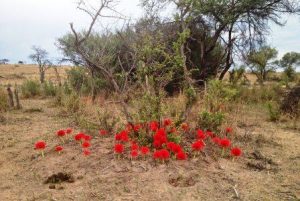
Scadoxus multiflorus. Photo:
Bart Wursten: Source: Flora of Zimbabwe
After a hot and harried day, we met at the dry Hillside Dams for Ian to eulogise on 3 Commiphoras – C.schimperi, C.mollis, C.africana. Various ways of identification were tried – and a novel way of deciding between schimperi (red slash) and Africana (cream Slash) was a great success. Along the way we saw the Scadoxus multiflorus (old name Haemanthus ) or fireball plants and then Geoff Archer, still feeling fit after climbing Inungu in the Matopos, led us a merry dance around the old stone walling that previous civilisations erected in the area — keep talking Geoff – we’ll listen!
Thank you Ian for all your efforts (including a trip to Matopos to get a comparable sample of C.marlothii) in making these McHEWs such a success.
TREE PLANTING
Hoping to “switch off” for the Christmas break on the Friday, we (Charles and Angela Sykes and Ken and Betty Blake) were recalled for work at a tree-planting ceremony, inaugurated by the Forestry Commission at Mguza Nature Reserve on Saturday, 21st December – just slightly late for the National Tree-planting Day!
A total of 20 trees were planted in a cleared (and holed) area near the Study Centre, which included Erythrina lysistemon, Olea europaea, Pappea capenes, Dais cotonifolia (indiganous?), Bolusanthus speciosus and Acacia nigrescens.
After the tree-planting we went on the newly trade “Zebra Loop Road” and after seeing a Dwarf‘ Bittern (1) we more upon a “mystree”, with enormous “hoya”-like flowers, which after research turned out to be Crossopteryx febrifuga a (not often seen in such array) and on to the quartz ridge which had us all excited over many Dalbergia melanoxylon, Diplorhynchus condolocarpon, Ochna pulchra and Turraea nilotica . This area must be visited again.
-KEN BLAKE
STARTING THE NEW YEAR RIGHT
New Year’s Day in Matabeleland was a hot, sunny day with blue skies and not a wisp of a cloud to start with. Nearly thirty of us arrived at the Blakes’ just before noon and found Ken rarin’ to go with his quizzes. Gay, colourful sun umbrellas dotted the lawn and Angie Murray was preparing her luncheon table in the garage which had been emptied of velocipedes and such like for the occasion.
Standing on the side of the lawn under the Jacaranda trees was a big board with photographs of trees, aloes and cacti, neatly displayed and numbered, resembling an exhibition which is what I thought it was. Soon I discovered we were expected to identify the pictures and fill in the botanical names on the cards provided. With deep concentration and much muttering we circled around the board and I got stuck on one numbered “20”. A friend sympathetically suggested that I turn the “2” into a “Z”. Knowing he was not supposed to help me I dared not ask more and started to think of what trees started with “Z”. I thought of Zossomathanus and Zombresiaca and such like knowing they did not really exist and finally decided I wae’a mindless Zombiclemistanza. If only my kind informer had told me to drop the “O” as well, it would have saved a lot of embarrassment, as, believe it or not,it was none other than Zizyphus mucronata, the first indigenous tree that I had learnt some time ago! By way of saving face, let me explain that the photograph was one of a branchlet and the leaves had a shiny, leathery appearance with threw me. After giving us what he considered adequate time, Ken called the competition closed and the prize winners were announced and were suitably rewarded for their efforts.
Then followed lunch. This was a sumptums affair as everyone contributed of their best and no doubt a few New Year’s resolutions were made to go on diet from 3 pm onwards. There were also delightful gifts thoughtfully and cleverly prepared by Angie for each member present – surprise packets with Latin descriptions of the contents requiring careful consideration and definition by the recipient before opening – thank you Angie.
Also at that time, as Charles Sykes has decided to resign as secretary after about 7 years in that position, a presentation was made, with the provision that he is still very much needed in the Society.
After lunch, a walk in the delightful bush country in and around the Blake’s property was headed by Ian McCausland who gave a talk on Commiphora spp. those identified were C.schimperi, C,africana , C.mollis and C.mossambicensis, followed by another mini-quiz.
Also seen on the walk was Sclerocarya birrea, Peltophorun africanum, Flueggea virosa,
Turrea nilotica, Erythrina latissima, Dichrostachys cinerea, Acacia galpinii, Combretum apiculatum, C.collinum, C.hereroensis, Grewia monticola, G.flaveacens and Pterocarpus lucens.
In late afternoon some cotton woolly clouds made their appearance but no-one in Matabeleland gets excited over them any more as it signifies nothing except the end to a good day. It was indeed a very good day — thank you Ken, Betty and Angie.
-CLEM van VLIET
MABUKUWENE – Sunday 5th January
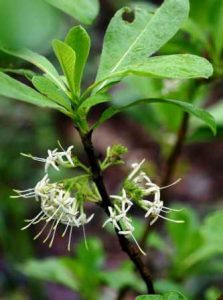
Pavetta schumnniana. Photo: Bart Wursten. Source: Flora of Zimbabwe
Billed as an outing to walk down our food from 4 days previously — and so it turned out to be, but after half an hour, and with 25 trees on the card and still within sight of the cars, my plaintive wail, “we are still not where I want us to go” pulled us on to another of the many tree walks in this very pleasant and well kept Nature Park.
The Pavetta schumnniana was looking beautiful, in full flower, as was the Grewia monticola, Shrebera alata, Psydrax livida, Acacia karroo, A.rahmanniana, Bridelia mollis and Bauhinia galpinii, and smelling like dirty socks, the Terminalia sericea, was not to be ignored.
We clambered over the rocks just like the Clerodendrum myricoides, C.glabrum, Ficus glumosa, Turraea nilotica, Euclea natalensis, Fllueggea virosa, Pavetta gardeniifolia and Pouzolzia mixta had done before us; and then Geoff set us several queries and had us searching for the answers with the various samples that he had picked along the way – such as Albizia antunesiana, Osyris lanceolata, Berchamia zeyheri, Ficus thonningii and Cassine transvaalensis just to keep us on our toes!
There is a large painted board at the entrance, with the many tree species of the Nature Park, as researched in the long past by Janet Webber, Alec Dry, Dora Webb and the late Nell Baxendale, which shows how impermanent the tree names are! But it gave us more trees to aim for, like Ficus sur (the only one found there), Dovyalis zeyheri, Xanthoxylum capense and Mimusops zeyheri which we then sat out to acquire on our list.
In all, 80 species were found, including reminders of our last McHEW outing, the Commiphora africana, C.mollis and C.schimperi and after a well-earned cup of tea we departed for home from a well attended and excellent morning tree outing – which we hope augurs well if all the future ones are as exciting.
In a previous article, I remarked on my admiration for the designs of “The wild Fruits of Zimbabwe‘ stamp issue, but now I have just found out that the artwork is from colour slides taken by our own Meg Coates-Palgrave – congratulations, Meg – it pays to “talk” to your camera!
“Come in Bulawayo” – Bob Aveley, while working for the municipality for many years, found it very relaxing doing lathe work on various types of wood, but soon found the most satisfaction with wild Olive (Olea europasa subsp. africana). The wide ranging Gwanda area contains a lot of dead trunks of all shapes and sizes, and soon his fame had spread. Now, with running his own Garden Care Services, and growing indigenous trees, his time is short, and the orders for clocks, ice buckets, pepper mills, standard lamps, bowls and knick—knacks come pouring in – so we are lucky to be able to get the popular key-rings and paper weights for the Tree Society.
Being a very hard wood, it is fascinating to see the shortened ( and variously shaped) chisels he uses (and keeps sharpening) in his immaculate workshop – the mark of a master craftsman and a man with feeling for this truly beautiful wood.
-KEN BLAKE
BON ACCORD, SHANGANI, RE-VISITED
In response to Sharon Brennan’s invitation to visit Bon Accord (Jabulani Safaris) to help her identify certain species from our Easter 1991 list, we went to Shangani on Saturday, 11th January.
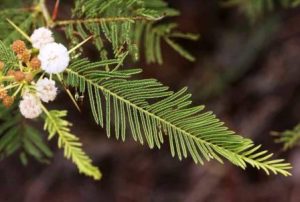
Acacia arenaria. Photo: Bart Wursten. Source: Flora of Zimbabwe
On the outward journey, approximately 60 km from Bulawayo, we stopped to investigate acacias, which proved to be Acacia arenaria and on the opposite side of the road were Albizia harveyii.
We received a warm welcome From Sharon and Debbie Lyon – the caterer For Jabulani Safaris. What a transformation has occurred from builder’s rubble and open trenches to the swimming pool full of water, the lawns green and mown and the thatched cottages ready for occupation. Each cottage is individually furnished “Laura Ashley” style with beautiful pieces ranging from sumptuous four-poster double beds in teak and oak to Victorian enamel baths with brass taps and dragon-claw feet. Sepia pioneer prints, oak-framed, complete the wall decorations.
We had a quick sortie into the back garden to show Sharon the Ekbergia benquelensis before setting off to the northern area of the farm specifically to find the Erythrina which “Jabulani” had to scale in order to obtain a few leaves. The general concensus was that it was Erythrina latissima. As always we had numerous stops en route, botanising and Ken pointed out differences in the aloe species we encountered.
We were served a delicious lunch in the garden, then set off for the southern sector where we were able to find specimens of Brachystegia glaucescens (but not B.boehmii as Sharon had hoped), Celtis africana, Maytenua undata, Euclea racamosa, Uapaca kirkiana and Tetradenia brevispicata, all of which were on Sharon’s list of queries. We could not recall where the Colophospermum mopane had been sighted, but Ian was able to lead her to Acacia nilotica and Ehretia amoena in the vicinity of the home- stead. Sharon introduced us to Loudatia simplex (used for brushes) and Elephantorrhiza elephantina and we saw Sericanths ardongensis and Tarenna neurophylla which we had not recorded previously.
The day passed all too quickly, as usual, and at 6.15 pm we headed torward home into the setting sun. A most enjoyable visit – thank you Sharon and Debbie.
-MARGARET MCCAUSLAND
P.S. This is really a good place to get away from it all with birds, animals and trees, and as a starting offer the price per each is 30% off the normal price of $250,00 for a full 24-hour period during February – and 20% off for March. Ideally you should arrive between 3-4 pm and be fed and watered before going on a tree walk or game drive. The price includes everything food, drinks, drives and guiding. Just bring clothing and a washbag – we think its really good value. P O Box 30, Shangani or telephone 0-1431, Shangani.
CHIPINGE AREA AND A VISIT TO TANDEVILLE FALLS — 11th JANUARY 1992
We set forth for these Falls on the Rusitu River, in three 4-wheel drive vehicles. Along the way we abandoned one which may not have made it across the steeply banked river. Had it not been a drought year we may not have made it at all!
Much of the journey was through invasive guava and lantana, but we were rewarded by arrival at a beautiful area of riverine vegetation and a magnificent waterfall cascading into a large pool.
Our first sight was of a creeper with bunches of bright orange fruit, some of which had split to reveal a shiny black seed with a bright red aril. A functionless telephone has prevented us from obtaining the name of this and other unknowns -so we’ll try to publish these at a later data (Our collector reports Agelaea pentagyna Ed.)
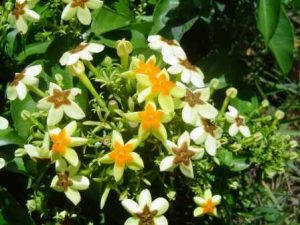
Mussaenda arcuata, Photo: Bart Wursten. Source: Flora of Zimbabwe
Mussaenda arcuata, a prolific riverine scrambler was everywhere in flower, and the spectacular Royal Fern, Osmunda regalis lined the banks.
We immediately came across a complete unknown with a strawberry-shaped fruit. This was expertly identified by Tessa as Cephalanthus natalensis, the “Tree Strawberry,” which has a small distribution area only in the extreme east of Zimbabwe.
Bersama abyssinica with its distinctively winged rachis is not some thing often seen by us, likewise Prunis africana (bitter almond) Myrianthus holstii with its digitately compound leaves, Schefflera umbellifera, and Halleria lucida the “tree fuchsia”. ,
Refreshed by regular dips in the pool, the explorers turned up three distinctly different waterberries Syzigium cordatum with its distinctive leaves, lacking a petiole. S.quineense was present as both subspecies, quineense and afromontanum, (previously gerrardii).
Bridelia micrantha formed remarkably large trees here, which seem to differ from those closer to Harare in possessing large spines on the trunk.
An unknown Ochna was weighed down with pinkish fruit – once again we’ll try to get a name for next month from our collector (our collector reports possibly Ochna arborsa var. O’Connorii.)
A plant with milky latex turned out to be Trilypisium (formerly Bosqueia) phoberos, the ‘False fig”. The growing point was that we typically associate with figs, but the fruit is a nut embedded in a fleshy fruit. They are, however, in the same family, MORACEAE, which also includes the exotic mulberry.
Other specials were Dodonea, Freylinia and Albizia adianthifolia, resembling Albizia gummifara but having rough bark.
-C and P Haxen.
CHIRIADA-SILVER STREAMS OUTING – 12th JANUARY 1992
The last day of our outing was spent travelling back to Harare via Birchenough Bridge with stops on the way chosen to take in the changing habitats and vegetation as we moved from moist miombo woodland along the Rusitu Valley, over the watershed into the Tanganda valley and down through the dry, arid bush around Tanganda Halt to the Save River. We started from Silver Streams in the last drops of an overnight downpour and got drier and hotter as we descended to the Bridge.
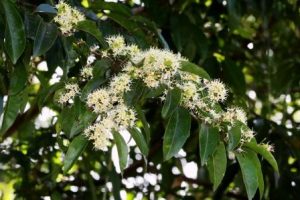
Pteleopsis myrtifolia. Photo: Bart Wursten. Source: Flora of Zimbbabwe
First Stop : We explored a stand of Pteleopsis woodland that Kim had noticed the day before along the Rusitu Valley. It was on land cleared previously for farming and now showed maybe 5 to 10 year’s regenerative growth with an occasional very large tree which had been left standing. It was predominantly Pteleopsis myrtifolia, more usually a constituent of jesse bush. This is one of the COMRETACEAE family with opposite to subopposite pointed leaves and small, two winged, straw coloured fruits in drooping branches. Here too, we found Markharnia obtusifolia with the same yellow and red flowers as M.zanzibarica (was M.acuminata with which we are more familiar, but with larger and more numerous leaflets. A rare find for the Tree Society (Patrick’s gem) was Hymenocardia acida with new, green, two winged, heart shaped fruits and the old deep red ones still on the tree. An observant Jenny Morris noticed yellow dots on the under surface of the leaves (later confirmed in Coates Palgrave, making a useful identification feature when keying it out against Phyllanthus and Margritaria species in the EUPHORBIACEAE family.
Second Stop : Travelling to our second stop we passed several Albizia procera, an introduced species which seems to be doing very well. We also noticed the pale trunks and peeling bark of A.tanganyicencis standing clear of surrounding bush. We stopped on the roadside near New Year’s Gift Estate to admire an enormous Ficus sansibarica absolutely identical to the L.chirundensis we had seen in the Forest with large fruits and large knobs along the branches and differing from it only in its location out of the Forest and in the wasp that pollinates it. Growing under this was what first looked like a member of the BIGNONIACEAE family ie. with opposite, compound, imparipinnate leaves. A close examination of the leaflets showed them to be gland dotted and to have the characteristic RUTACER (Citrus) family smell. This was Fageropsis angolensis, the exception to the opposite, pinnate leaf rule. Also here, Trichillia dregeana, Tabernaemontana elegans complete with lots of gaping toads, and a tree unfamiliar to us in the highveld, Senna petersiana (was Cassia), with its huge leaf like stipules.
Third Stop : Now we were well over the watershed, out of the moist miombo woodland and into much drier country with the first Adansonia digitata making its appearance. A really dramatic change in the space of 10 or so kilometres. Colophospermum mopane now everywhere and many Acacia species evident, also Kirkia acuminata and Euphorbia engens. Our stop was at an area of depositional sand at the bottom of a rock strewn hillside. In the sand, Acacia karoo, A.gerrardii, A.nilotica, A.nigrescens and A.erubescens. This last unfamiliar to us with its stout; blue curved thorns and papery bark. Here too various Commiphora species, C.mossambicensis, C.africana with its small, furry, trifoliate leaves, C.pyracanthoides and C.mollis. On the hill many delicate leaved Brachystegia glaucensens drooping somewhat in the heat, and an exciting Sterculia rogersii squat, with a pink and purple blotched trunk and small Acer like leaves. Its fruits similar, but half the size of S.africana. (Handle with care – both have very irritant hairs at their mouths.) This was a really an interesting stop, an apparent world away from the lush forest and riverine growth of the previous two days, now only 70 kilometres behind us.
Fourth Stop : This became a lunch stop where we looked at one of the baobabs covered in “sooty mould”, Jonathan Timberlake, now working with the Forestry Commission, gave us a short resume of current thinking on the subject. There is still debate as to whether the “soot” kills the tree or not. It is in fact a black smut – a secondary fungus which invades already “sick” trees. There are brown pustules on infected trees, these exuding a milky sap which may attract invasion by the smut. Infected trees showed drooping leaves and branches compared to non sooty neighbours. Further along the road we discovered a very large black tree whose main branches had collapsed completely. What causes the initial sickness is unknown, although drought stress has been suggested. Trees in both the Zambezi Valley and the Birchenough Bridge area are affected. Apparently in l948 the Big Tree at Victoria Falls was infected in this way, and a tree at Tsholotsho a 100 years ago too. Both are still healthily with us, so maybe it is not all doom and gloom for these lovable giants. Still at our lunch spot we picnicked beside a Cardiogyne africana another first for many of us. Coates Palgrave says that the roots and leaves are used to treat snake bite and, appropriately, our lunch was interrupted by the appearance of a very small, thin, metallic black slow-worm/snake. “Slow” however was what it wasn’t as it wriggled off with the Haxen family in hot pursuit. It spent lunch in a cup being lovingly admired by Kenneth, later to be set free.
Fifth Stop: This was a brief affair to look at a row of Xanthocercis zambesiaca (Nyala tree) only a few kilometres from Birchenough Bridge spanning the very dry Sabe River. These are enormous, beautifully shaped trees with drooping branches and small, delicate leaflets, and although a member of the PAPILLIONOIDEAE Family, with fruits that are not legumonous pods, but berries with single shiny seeds.
After the Bridge, a very noticeable tree even as we were whizzing along was Commiphora merkeri with its distinctive, horizontally zebra-striped bark. On stopping to have a closer look we found the leaves clustered in rosettes on short, spine tipped side shoots, much like C.pyrocanthoides, but the barks make differentiation simple. Growing beside it was an Adonia spinosa. Among the kopjies on the way to the Gutu turn off we saw Euphorbia confinalis with their candelabra crowns of branchlets. These without the heart shaped segments of E.coopari. Once off the Birchenough/Masvingo road our party of four vehicles found their own speeds and so to Harare and home. What a day!
Many thanks to our ‘fundis’ Kim and Jonathan for making it so enjoyable. Aren’t we lucky in the Tree Society to have such accessible and “giving” experts all to ourselves? Thank you too to Maureen for organizing it all so unfussily and efficiently. Lastly and very importantly, thank you to Rose and Derek Rigden for their kind hospitality and their suggestions for good “treeing” places. –
-Fiona Dawe
McHEW – Wednesday l5th January
The Cause: Cussonia species: The Effect: A long energy-sapping, but health-giving walk across the dry upper Hillside dam, passing the site of the original coffer dam wall built and breached at the turn of the century.
It is unusual to find the two species, Cussonia natalensis and C.arborea in such close proximity, but Ian had found just that, and we worked on the differences during a long discussion, in which Betty’s nemonic, that the five divisions of C.natalensis palmate leaf represent the five provinces (including SWA/Namibia!) of South Africa, came under consideration – and accepted! while the C.arborea usually has +- 8 digitata leaflets .
Having passed through the ruined walls of the ancients, once again Charles posed his comudrum that Celtis africana is nearly always present at old ruins, and wondered if there is any connection?
Thank you Ian, for another very well attended and thought provoking McHEW.
-KEN BLAKE.
VISIT T0 TSINDI RUINS : 19th JANUARY 1992
I joined a small group of late comers at the car park at Tsindi Ruins Monument and headed off to join the main party. We could hear them in the distance but we sauntered along and looked at the trees along the path to the Ruins. A very old Brachystegia glaucescens on a rocky outcrop, caught my eye. According to George this tree fell over a long time ago, the main thick trunk now lying prostrate, with roots having formed at its apex, and a branch now the trunk. The leaves of B.Glaucescens on the kopje seem larger than usual, the bark having the characteristic flaking discs. At the ‘foot’ of this big tree we saw a small sapling of Clerodendron wildii. On the other side of the pathway we saw a Cussonia spinata or on reflection C.natalensis inflorescence not present. Side by side near the path were a Faurea saligna and Pterocarpus angolensis. 0n the path itself we saw a distorted “bonsaid” Mukwa, obviously under great pressure but still surviving – fruits present but somewhat misshapen. Further up the Kopje there was an Ochna puberula – granite ochna. The leaves noticeably serrated,both flowers and fruit were present. The red persistent sepals surrounding the black seeds and just opening back.
Nearer to the ruins we found a Vitex payos with fruit present. Several Hymenodictyon were present near the entrance to the ruins. Their leaves a dark glossy green now, interpetiolar stipules present, a characteristic of RUBIACEAE. The remains of floral heads present but seeds already dispersed. This is the Firebush – I’ve promised myself a trip back to see them when the leaves turn crimson, in Autumn.
We joined the main group just inside the ruins, and were Just in time to see some interesting trees. Diospyros natalensis, EBENACEAE family seems to be wide spread on the Kopje within the ruins.
Apodytes dimidiata was just coming into flower, and had lime green leaves. Maytenus undata has noticeable serrations with dark tips, the under leaf surface is waxy. The presence or Azanza garckeana gave rise to an interesting talk from Kim. Azanza is in the family MALVACEAE. It shares a noticable characteristic with the family TILIACEAE and SOMBACACEAE, namely its slimy nature. Another interesting point about Azanza is that the hairy nature of the leaves and fruit can give rise to Bezoars — hair or fur balls – if included in ones diet. Some cases have been noted. Interesting also Diospyros mespiliformis has also been identified as a causal agent, so ‘snot apple ‘ and Diospyros eaters beware.
From the hilltop one gets a panoramic view of the land. Dark rain clouds over Wedza, to the east and Mutoko to the north were good to see.
The presence of compound opposite leaves leads for easy identification, and takes one to the back of Coates Palgrave. Schrebera alata, the small wooden pear tree was present on the edge of the Kopie almost inaccessible. It was in full flower, the creamy white inflorescence giving off a heavenly scent, reminiscent of Jasmine. The tubular flower has “funny four” petals appearing as 5 or 7, all fused and forming a tube. The leaves are compound, opposite and possess wings also on the petiole – hence its name. A Pavetta gardeniifolia was seen nearby flowering, the leaves showing characteristic black spots caused by bacteria, Around the Kopje we found more Vitex payos the presence of Gloriosa supurba all around was a pleasure to see.
A fine Ficus natalensis was found on the north side of the Kopje. All around this part the ground was scattered with pottery shards. One member said it would be interesting to travel back in time and see what life was like when the site was occupied. Rain began to fall as we headed downhill for lunch.
-Vera Neill.
After lunch we headed off across a vlei to another range of Kopjes to find some bushman paintings which Meg Childes remembered from her childhood. The paintings are some of the best preserved I’ve seen and once again Rob led to into an interesting discussion on the little men and their art and its meaning. Thank you Rob.
NYARUPINDA CATCHMENT JANUARY 1992
Retrospect 1991. The Nyarupinda river stopped flowing soon after the rains (which totalled 580 mm) ended in March. Alas, rivers do not flow like they used to in the old days. They have suffered at the hands of man. Thirsty cattle and pumps have sucked the pools and the dam almost dry.
Prolonged dry conditions throughout much of the country have once again made a nonsense of the Tree Planting Day early in December. It is best to wait for congenial weather and soil conditions.
The pleasure of seeing December’s indigenous flowers is often missed because of the festive seasons domesticity, comings and goings. This year the plants associated with Christmas in Zimbabwe were on show on time. There were ripe red berries on what formerly was called Rhodesian holly Psorospermum febrifigum; flame lily plants and flowers were smaller than usual, the weather has not affected the climbing type of Gloriosa superba. Christmas bush Pavetta schumanniana has plenty of blossom, it could be called entomologist’s delight because it attracts many insects, as we watched, small hawk moths zig-zagged between its clusters of scented white flowers at sundown; yet they did not hover to feed. Mistletoes, Viscum sp. usually grow high up on the host tree in sheltered places where mist can swirl around them. It is unfortunate that their braches are too brittle to be used for decoration, unlike their European counterpart Viscum album. Mistletoe fruits attract birds which disperse the seeds. Is it not ironic that the berries may be boiled then mixed with oil to make birdlime.
Sarcostemma viminale is in flower here now.
Christmas. A sour plum candle burned brightly near the Nativity scene in a Zimbabwe landscape (with mirror dam, game and farm animals.) on the hearth in the sitting room at Tinto. Many of you who have been here can picture this. The children watched the reflections in the water, made by the lights in the Cypress Forest which sheltered the stable at Bethlehem. Outside, the sky was heavily overcast with the first good rain in this part of the district. Rain at last, thank Goodness!
It is a pity to separate observation of trees from that of animals when they happen together. Here are a few recent events.
Two moist overcast days ended the hibernation of a large land snail Achatina species, a short distance from it a birds nest lay on the ground, it was identical to the one reported from here in Tree Life No. l36 June 1991. It was made by a Grey Penduline Tit, some Pericopsis leaflets were attached to the nest, overhead there was a young Pericopsis, this site was approximately 200m from the nest in the Pseudlachnostylis maprounifolia near the dam. Each nest was lined thickly with plant down of Fleabane, Conyza sp.
We watched from indoors a pair of Scarlet chested Sunbirds as they danced along their respective branches under the canopy of a Julbernardia tree. He indicated that she should find one of his outstretched wings and then the other, alluring. She declined this invitation, he alighted on her branch, she moved away, just far enough, she watched him show off but did not want to come under his wing. The performance ended when he flew one way and she the other.
Tree Mapping
Paul Zwanikken and the writer located Shrebera trichoclada and Erythrococca trichogyna on 18th November 1991 at the foot of Jess kopje which overlooks the river valleys of the Susuje and Nyarupinda, ref. Mutorashanga map 1730 B1. R specimen of each tree was identified at the Herbarium. A search for the longer fruited wooden pear and the fruit of twin red berry will make us return to this place. Our attention was drawn to the former species because of its distinctive leaves, like rippled velvet, and its Jasmine like Flowers. ‘Tricho—’ is a Greek word which means hair or filament.
During this walk we admired Kirkia acuminata’s flat panicles of unopened flowers at eye level, a parasite or something had already distorted same of the minute buds. Then Paul noticed some animal hairs on the rock where we stood, was this moulted hair or an accident? the length, colour, and texture of the hair suggest klipspringer….
Some Trees in the Republic of Ireland
Soon after leaving the ferry at Cobh (Cove) honeysuckle and wild fuchsias spilled on to the narrow roads along the coasts of southwestern Ireland. We saw pink flowered heaths, related to Arbutus, both belonged to the heather Family ERICACEAE.
Arbutus unedo strawberry tree has a specific name which means Eat One, they are sour and seedy, for the birds is apt, but what about this: –
‘My love’s an Arbutus in the Forest of Lane,
So lovely and shapely in her girdle of green‘.
Lines by the poet A.P. Graves. Lana referred to Lough Leane Killarney. A British flora written one hundred years ago had this to say ‘Arbutus is abundant about the lakes of Killarney and near Glengarrif. A recent booklet in the Irish Environmental Library Series has this information, ‘a great number of trees (Arbutus) were cut down by charcoal burners, two hundred years ago, to make charcoal for iron smelting, it has become rare.
In Bantry Bay tourists visit the Island of Holly, ‘Ilnacullin’ in Gaelic. Here landscaped gardens blend with mountain scenery. Earth and humus were brought from the mainland so as to be able to grow a wide range of oriental and southern hemisphere herbaceous plants, shrubs and trees. The illustrated guide to the gardens is First rate and of‘ lasting horticultural interest. 2000mm rain a year is not unusual on Ilnacullin. we saw holly Ilex aquifolium both wild and cultivated, its wood is carveable and has an ivory like texture and colour. African holly Ilex mitis deserves to be mentioned in this letter, its pale wood makes durable chopping boards, what a rare Christmas gift that would be, Ilex mitis berries are not ready for Christmas, they ripen in winter.
Valentia Island, famous for submarine telegraph and the weather observatory, used to be called Island of the Oaks, Oilean Dairbre in Gaelic. We were disappointed that the Valentia Heritage Display Centre lacked information about the oaks Quercus robur, in the local history – no mention of the craft of carving Irish bog-oak by the peasants in former days. This would have been interesting because there was a huge bog oak bed, for two, in the beam room at my age-old Kentish home.
In the bedheed a sliding panel hid a recess ror a bible and maybe a bottle of spiritual comfort. Seasoned Irish oak looks like ebony. It is difficult to believe that these trees grew in continuously sodden oxygen-less, acid phosphate deficient environment. Bog oak was so called because it be found embedded in decaying vegetable matter in peat bogs. Some further reading – is a must, the National Geographic, “Mysteries of the Bog“ in Vol l7l no
3 March 1987, and reader’s letters about this article in Vol 172 no. 1 July, 1937.
A landscape feature in the Republic of Ireland is the lack of trees, only about two per cent of the vegetation in woodland, bog occupies approximately one fifth of‘ the land apart from water, the remainder is grass, heather, ferns and low-growing shrubs, not forgetting the shamrock, the green, immortal Shamrock’.
Towards evening we drove past the Burren in County Clare, catching glimpses of hazel Corylus avellena coppice and stunted holly bushes growing in fissures in a vast area of very smooth gently unduleting sheetsof rock. The flora, geology. archaeology, legends and history are explained at the Burron Display Centre in the village of Kilfenora. This centre won an award for display excellence. By all accounts the Burron ie most memorable in the Spring when all the flowers are in bloom. Plenty of time should be allowed for the ‘centre’
and to do justice to his unique environment of the Burren. We missed the opportunity of learning about the natural history of thi area which in south of Galway bay and which overlooks the islands of Aran.
The foregoing incomplete observations lead to some questions; how long has the vegetation of Ireland been like it is now? was there an era when the climate and soils were conducive to the growth of trees? If there were more trees formerly, why have they disappeared? if the worst came to the worst in Ireland, we hope it does not happen here in Zimbabwe.
-Benedicta Graves
KIM DAMSTRA CHAIRMAN


